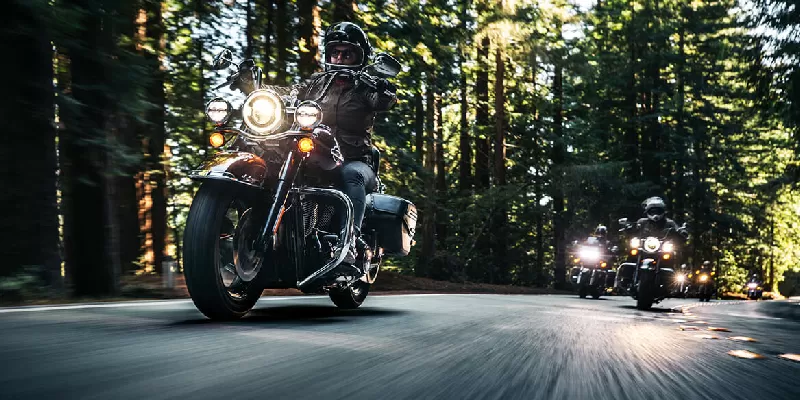
How to ensure the safety of motorcycle group riding trip
Motorcycle riding is generally considered more dangerous than car driving Because motorcycles offer little to no protection for riders in the event of a collision. Therefore, if you are starting a motorcycle group riding trip, there are some points you need to know to mitigate the risk and ensure safety while riding.
Group Meeting Before The Riding
Before the trip, gather all participants for a preparation of trip meeting to discuss the route, stops, and safety guidelines. Ensure everyone understands the itinerary and safety protocols.
Choose An Ideal Group Size
Group size is essential during group riding. Ideal group size can maximize safety during the trip. Here are reasons why small group is better.
- Small Group Is Good For Visibility
Larger groups can be less visible to other motorists, increasing the risk of not being seen, especially in traffic. Smaller groups are easier for drivers to notice.
- Communication
Effective communication among riders is crucial for safety. Smaller groups make it easier for riders to communicate using hand signals, intercom systems, or visual cues.
- Keeping Together
Larger groups may have difficulty staying together, especially on winding or congested roads. Smaller groups can maintain better cohesion.
- Traffic Management
Managing traffic and intersections is more straightforward with a smaller group. Large groups may struggle to navigate busy intersections as a single unit.
Keep the group size manageable, ideally between 5 to 10 riders. Smaller groups are easier to manage and reduce the risk of confusion.
Decide Ride Leader and Tail Rider
Appoint an experienced ride leader to set the pace and lead the group. Assign a tail rider to ensure no one falls behind or encounters issues.
Riding Order
Establish a riding order and stick to it throughout the trip. Typically, the leader rides at the front, followed by the sweeper, and the rest of the group rides in staggered formation.
Communication
Equip all riders with two-way radios or Bluetooth communication systems to maintain constant communication. This helps in relaying important information and warnings. Here are some brands you can consider
- Sena
Sena is a leading brand known for its innovative and feature-rich Bluetooth intercom systems for motorcycle riders. They offer a wide range of products catering to various needs and budgets.
- Cardo Systems
Cardo is another prominent brand, known for its communication systems like the Cardo PACKTALK series. Their products are praised for their ease of use and advanced features.
- EJEAS
EJEAS is a reputable brand in the motorcycle Bluetooth intercom market, known for its quality and reliability. Their intercom systems offer seamless communication between riders, with features like long-range connectivity, noise reduction technology, and hands-free operation. EJEAS intercoms are designed for easy installation in motorcycle helmets and provide crystal-clear audio even at high speeds. With user-friendly interfaces and compatibility with various devices, EJEAS intercoms enhance the riding experience, ensuring safety and connectivity for motorcycle enthusiasts.
Safety Gear
Require all participants to wear appropriate safety gear, including helmets, gloves, jackets, pants, and sturdy boots. Consider high-visibility clothing for added safety.
Rider Skill Levels:
Be mindful of the riders’ skill levels and choose a route that suits the least experienced rider. Encourage everyone to ride within their comfort zones.
Rest Breaks
Plan regular rest breaks and stops for fuel, hydration, and stretching. Fatigue can impair concentration, so well-timed breaks are essential.
Weather and Road Conditions
Monitor weather forecasts and road conditions along your route. Be prepared to adjust the itinerary if necessary to avoid adverse weather or unsafe roads.
Road Etiquette
Emphasize safe riding practices, such as maintaining a safe following distance, obeying speed limits, and using turn signals. Remind riders to stay focused and avoid distractions.
Emergency Plan
Develop an emergency plan that includes contact information for local emergency services, nearby hospitals, and tow services. Ensure everyone knows how to call for help if needed.
Be Flexible
Be flexible with your itinerary. Unexpected delays or changes may occur, so adapt as needed to ensure everyone’s safety and enjoyment.
Share Local Laws
Familiarize all riders with the local traffic laws and regulations in the areas you’ll be traveling through.
Respect Local Communities
Encourage group members to be respectful of local communities and residents. Keep noise levels down, dispose of trash responsibly, and follow local customs and rules.
First Aid Kit
Carry a basic first aid kit in case of minor injuries, and ensure someone in the group is trained in first aid.
Regular Check-Ins
Establish a system for regular check-ins during the ride to ensure everyone is accounted for.
